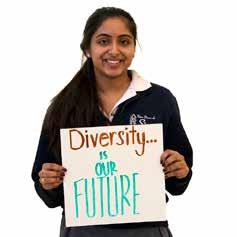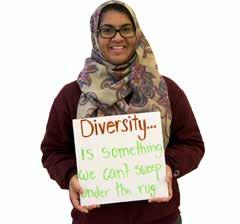
5 minute read
SEED and Interfaith Assembly Club members collaborate and create an eye-opening video, encouraging dialogue
from March 2015
by Le Journal
Cultivating a Future
Leaders of Students Educating and Exploring Diversity Club and Interfaith Club collaborated and led an unprecedented assembly addressing diversity misconceptions.
Advertisement
BY SOPHIE NEDELCO REPORTER
Eight people were given one hour. An hour and a half including discussion. To them, it was a gift of time, but a gift that had to be opened delicately. These people are the sponsors and leaders of Students Exploring and Educating Diversity Club and Interfaith Club. How they chose to spend their gift of time: addressing the importance of diversity and the ignorance that buries it.
The chance to host an interfaith assembly is an annual gift, but this year with seniors Zoya Khan and Rose Puthumana serving as co-presidents of SEED Club as well as leaders of Interfaith Club, the March 24 assembly transpired as a joint effort between the two.
According to club sponsor Kristin Pennock, SEED Club is a forum for students to discuss issues regarding the many different forms of diversity. Likewise, Interfaith Club inspires understanding through interacting with people of different faiths, according to club sponsor April Schendel.
Members of both clubs since freshman year, Khan and Puthumana have noticed a repetition of stories shared during the meetings. The two seniors searched for ways to share these experiences, and the assembly became the platform for just that.
“The entire school is not in SEED, and I think everyone could benefit from having those conversations and being involved in that type of dialogue,” Puthumana said.
A questionnaire seeking students to anonymously share personal stories and experiences relating to diversity was sent out Jan. 12 and became the foundation of a video that was shown at the assembly. The survey of nine questions elicited 85 eye-opening responses.
“[The survey responses] are as diverse as Sion is diverse… many of them positive, some of them not as positive. I think they are a good, accurate representation of the different experiences people have had,” Pennock said.
The video, created by Interfaith Club member senior Katie Kenfield, was intended to represent students’ stories while addressing ignorance regarding diversity and the problems sprouting out of a lack of education on these topics.
“There’s a major emphasis this year on trying to eradicate ignorance when people don’t realize what they’re saying or what they’re doing is kind of offending somebody or sometimes downright hurting them,” Schendel said.
While the video was intended to focus on students’ personal stories, diversity ignorance is not initiated at Sion, but rather has historically occurred in society. The lack of communication that surfaced in Ferguson, Missouri in August was an example of this.
“They’re global issues and something that exists throughout the country and throughout our community for sure, but I think what makes Sion unique is that we have the space and this place to have these conversations,” Puthumana said.
Along with the video, Diversity and Inclusion Consultant Vickie Harris spoke at the assembly. Harris understands the taboo on diversity that can bar some people from maintaining healthy dialogue on this topic.
“I think people don’t always know how to have the conversation [on diversity], and I think that keeps people from having them sometimes. And that’s very natural,” Harris said.
According to Khan, acceptance of diversity is only the first tier in diminishing discrimination and prejudices. Once understanding of other groups has been achieved, society will then be able to thrive in peace. That goal coincides with the mission of Sion.
“This particular assembly [spoke] directly to who we are as Sion and how we are rooted in Sion,” Mission Director Penny Selle said.
The SEED and Interfaith Club members agree, a single assembly is not enough to conquer minds set in stone with prejudices. And extreme misconceptions may be immune to attempts of destroying them. But this group of eight has faith. “I don’t know that you can necessarily reverse deeply rooted prejudice. I think what you can do is build a society where it doesn’t get replicated,” Pennock said. The group knows exactly where to start in altering future prejudices and assuring an end to reproductions of them. “[Diversity misconceptions] need to be addressed in the classroom to be uprooted and by people knowing what they’re doing is wrong. By addressing these ignorances, it will definitely prove to be beneficial,” Kentfield said. Following Harris’ talk and the video, students split into small groups to express their thoughts on the assembly and to brainstorm ways to end these misconceptions. According to Pennock, the assembly was met with a positive response and generated productive conversations within the groups. “We never expected to snap our fingers and change everything,” Schendel said. “But we hoped that people would listen and care and make an effort to talk about it. And they did.” Group responses to the assembly were recorded in notes taken by SEED club members, and students filled out slips of paper detailing how they can “be the change.” “I really think that we achieved what we wanted to achieve,” junior leader of SEED club and Interfaith club Manahil Khan said. “I think the work they put into [the assembly] really showed with the responses, and I was really proud of that.” Education is the only cure for ignorance, but it is a forceful cure, with a far-reaching ripple effect that expands across generations. “We want to be active in our community,” Khan said. “Not only by talking about it, but by positive action.”
of Understanding







Clockwise from top left: junior Manahil Khan, senior Rose Puthumana, Social Studies teacher Kristin Pennock, Librarian Jennifer Campbell, senior Zoya Khan, junior Alyssa Moncure, Spanish teacher April Schendel and senior Katie Kentfield share their personal views on diversity.
21LE JOURNAL MARCH









